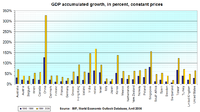
Photo from wikipedia
As the global economy begins to recover, tremendous efforts will be needed to build back better to ensure decent, fulfilling, and secure work for all within an environmentally sustainable economy.… Click to show full abstract
As the global economy begins to recover, tremendous efforts will be needed to build back better to ensure decent, fulfilling, and secure work for all within an environmentally sustainable economy. Based on the perspective of communication science, this paper first constructed a comprehensive evaluation system of regional economic sustainable development indicators. Next, the least square regression model, spatial effect regression model, and two-way fixed effect regression model are used to analyze the panel data in 34 provinces and cities in China. This paper makes a detailed study on how population flow and agglomeration affect economic growth and sustainable economic development. The experiment result shows that: (1) the impact of population agglomeration on sustainable economic growth has an “inverted U” non-linear characteristic. (2) Population agglomeration promotes sustainable economic development by improving the urbanization rate. Furthermore, based on the VAR model, Granger causality analysis and co-integration technique are used to study the quantitative interaction between population growth rate and economic development level in China. The result indicates that (at the 5%-level significance): (1) in the short-term, the population growth rate has no significant effect on the economic development, while the economic development level has a significant effect on the population growth rate; (2) there is a significant negative correlation between population growth rate and economic development level in the long run.
Journal Title: Frontiers in Psychology
Year Published: 2022
Link to full text (if available)
Share on Social Media: Sign Up to like & get
recommendations!